 |
||||||||||
| Technical Audio Devices aka TAD is a division of Pioneer and famous for peak-performance recording studio applications where their exotic compression drivers have won a reputation for world's best. Pioneered at CES 2003, TAD's new home division is reaching for a foothold in consumer audio under the leadership of Andrew Jones, Director of Engineering, and Brett Frank, Senior Design Engineer. And make no mistake - their products are the technically most advanced dynamic production loudspeakers currently available to the home-based music lover. To present visual appreciation for certain unique key features, I procured some cutaway drawings from Brett Frank. |
||||||||||
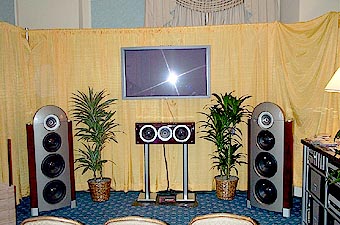 |
 |
|||||||||
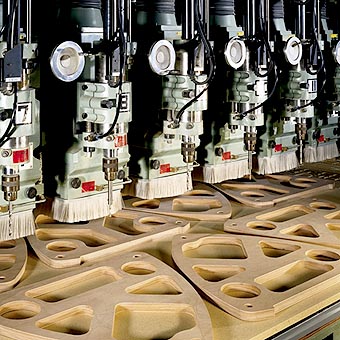 |
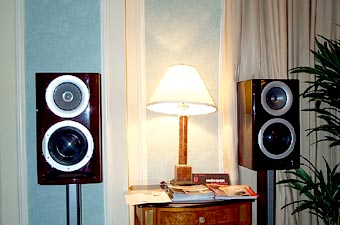 |
|||||||||
 |
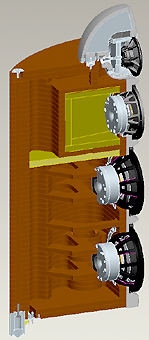 |
|||||||||
 |
||||||||||
 |
||||||||||
 |
The Model 1 ($45,000/pr) is a full-blown, 285 lbs each assault on the state of the art. More than fifty laminated Birch ply slices make up the main chassis to create extensive internal crossbracing and porting without the traditional tongue'n'groove glue joints. Like the head of Vandersteen's Model 5 or the egg-shape of Gershman's Opera Sauvage, this method allows compound angles and curves to avoid internal standing waves. It optimizes the cabinet against flex from high retrograde SPLs and thus creates an inert launching platform to maxi-mize dynamics performance without cabinet "talk". | |||||||||
| Vapor-deposited Beryllium domes make up the dual-concentric tweeter/mid diaphragms to create the most extreme weight/stiffness ratio of any diaphragm material extant. | ||||||||||
While the recent introduction of JMlab's Beryllium Series has turned the spotlight on this very expensive material (long since outlawed in professional racing due to production challenges in managing its toxidity during handling), it's fair to remind the reader that TAD has used Beryllium drivers for the last 25 years. The shallow geometry of the midrange cone avoids the unintentional wave-guide/horn-loading effects common with coaxial designs and is said to create more linear off-axis response and virtual point source behavior. A feature dubbed ISO Drive couples the twin-driver's motor/chassis to elostomeric damping structures inside the curved head, absorbing and isolating mechanical vibration from the baffle for enhanced micro detail. A 200mm tri-layer composite midbass cone of a Carbon-fiber derivative with central foam damping and twin equivalent 250mm bass drivers make up the 4-way driver complement. A matching center channel and under-works rears complete TAD's first entry into the 2-channel/multi-channel consumer market. The demo system used the Bel Canto Design PLayer, PRe6 and high-power Classe CAM-350 monos. So, how did the Model 1s sound? At CES, I was impressed with their potential but critical of the actual performance. Andrew and Brett acknowledged that they too had perceived certain areas of weakness and itemized very specific areas of subsequent address. Whatever they did clearly worked. While the room was a bit smaller than ideal for these turbo-charged monsters, it was transparent that these designs fall somewhere between the Focus and Adrenaline Classes we've playfully established at the onset of this report. Ultra-dynamic, suffering zero audible break-up or ringing, Andrew for a quick 15 seconds double-clutched the volume control throttle and brutalized the audience with Marcus Miller doing his trademark slap- and power bass funk, at decibels in the low 100s. It conjured up images of Bruce Lee's mechanical punching machine rumored to have caused his untimely death via an unblocked hit to the skull - precise, fast, lethal. This uncanny sock'em ability was coupled to extraordinarily precise focus. During the Witches Sabbath of Mussorgsky's "Night on Bald Mountain", the speakers managed to recreate the stepped-arch array of the orchestra, with the trumpets and tympani clearly placed higher than the woodwinds, themselves placed higher than the strings. Fascinating, this - image specificity along the vertical axis. The flipside of such ultra-precision? A nearfield perspective in terms of transient rise time sharpness. Mellower designs with cabinet fuzz and less pistonic accuracy create a somewhat more blended, slightly amorphous, softer farfield effect (regardless of listening distance). TAD's approach with its deep roots in professional monitoring clearly and methodically revolves around exactitude and freedom from dynamic compression. Assuming this was the design objective, I'd say mission accomplished - heroically. I'd love to hear these with the Rogue Audio Zeus in ultralinear mode ... |
||||||||||
 |
Though I was going to leave Home Theater to others better equipped, one exhibit caught my attention: Tannoy. Their new Eyris iDP range uses fully active, DSP-controlled speaker models with 250/500-watt modules for HF/LF driver arrays and 1000-watt power for the dual 12" aluminum-coned subwoofer. Comprehensive menus allow control over frequency response; acoustic profiling for free space/close-wall/on-wall/corner placement; programmable acoustical delay; various EQ voicings for film, broadcast, stereo, mood; bass management with assignable presets for AV or 2.1; global volume, system mute, reference levels; interface with Crestron, AMX and Pronto - while networking facilites allow expansion for 5.2, 6.1 etc and can accept direct digital 192kHz inputs in the future. | |||||||||
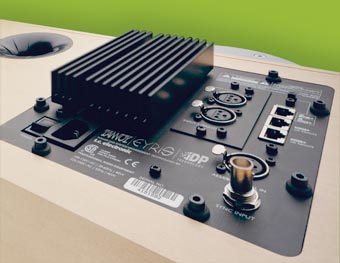 |
 |
|||||||||
This smart range from Tannoy is the first outgrowth of its 2002 merger with TC Electronic, a pioneer of DSP applications for the professional audio industry. Naturally, the speakers incorporate Tannoy's dual-concentric as well as super-tweeter technology. The combination of all this struck me as the DSP-equivalent engineering marvel to TAD's mechanical advances and is a prime example of the convergence of multiple high-tech sectors in consumer audio that herald a new era of serious engineering. |
||||||||||
 |
||||||||||
 |
||||||||||
 |
||||||||||